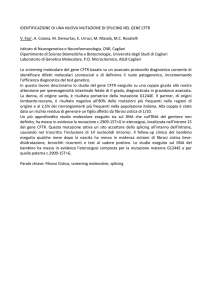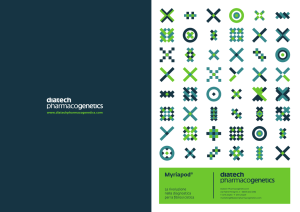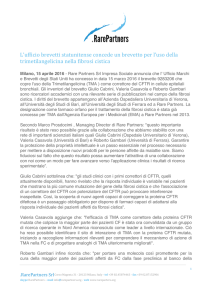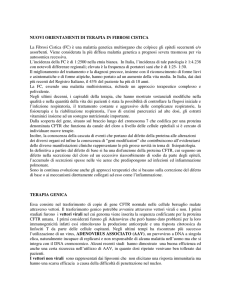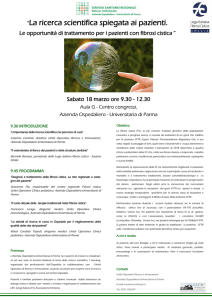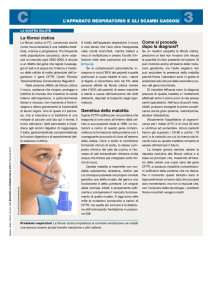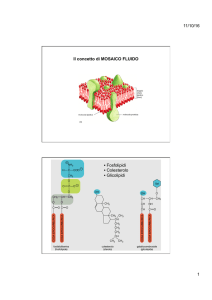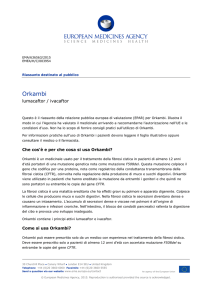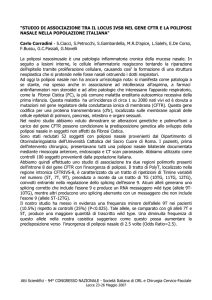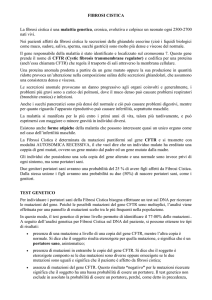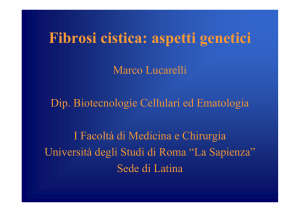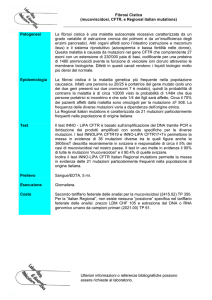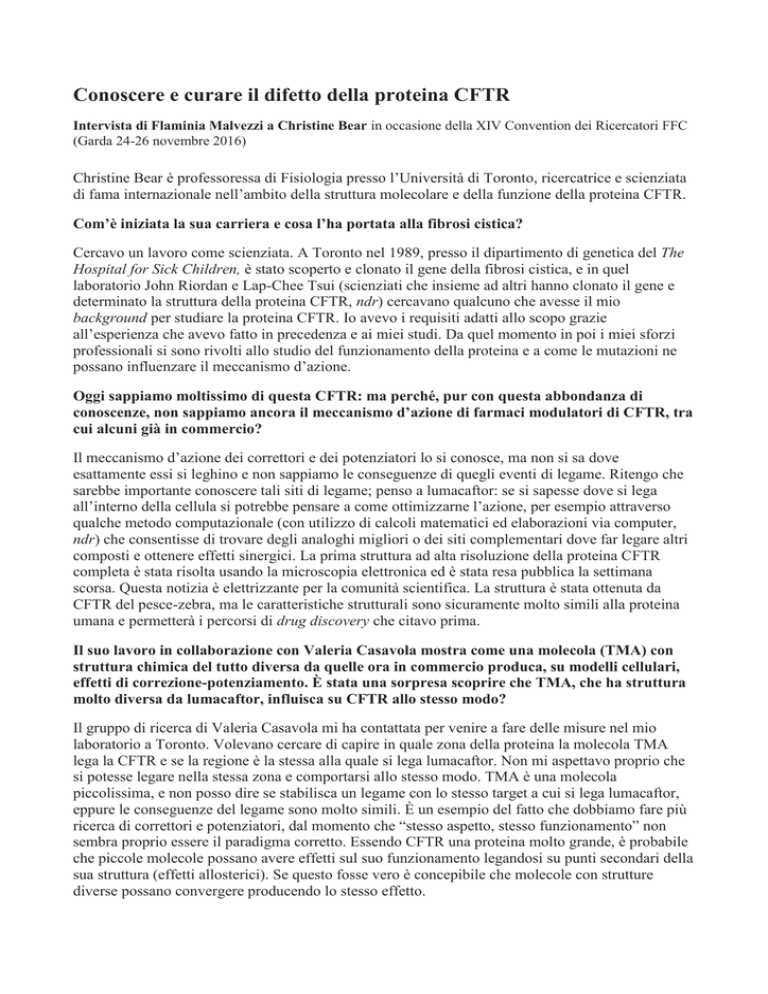
Conoscere e curare il difetto della proteina CFTR
Intervista di Flaminia Malvezzi a Christine Bear in occasione della XIV Convention dei Ricercatori FFC
(Garda 24-26 novembre 2016)
Christine Bear è professoressa di Fisiologia presso l’Università di Toronto, ricercatrice e scienziata
di fama internazionale nell’ambito della struttura molecolare e della funzione della proteina CFTR.
Com’è iniziata la sua carriera e cosa l’ha portata alla fibrosi cistica?
Cercavo un lavoro come scienziata. A Toronto nel 1989, presso il dipartimento di genetica del The
Hospital for Sick Children, è stato scoperto e clonato il gene della fibrosi cistica, e in quel
laboratorio John Riordan e Lap-Chee Tsui (scienziati che insieme ad altri hanno clonato il gene e
determinato la struttura della proteina CFTR, ndr) cercavano qualcuno che avesse il mio
background per studiare la proteina CFTR. Io avevo i requisiti adatti allo scopo grazie
all’esperienza che avevo fatto in precedenza e ai miei studi. Da quel momento in poi i miei sforzi
professionali si sono rivolti allo studio del funzionamento della proteina e a come le mutazioni ne
possano influenzare il meccanismo d’azione.
Oggi sappiamo moltissimo di questa CFTR: ma perché, pur con questa abbondanza di
conoscenze, non sappiamo ancora il meccanismo d’azione di farmaci modulatori di CFTR, tra
cui alcuni già in commercio?
Il meccanismo d’azione dei correttori e dei potenziatori lo si conosce, ma non si sa dove
esattamente essi si leghino e non sappiamo le conseguenze di quegli eventi di legame. Ritengo che
sarebbe importante conoscere tali siti di legame; penso a lumacaftor: se si sapesse dove si lega
all’interno della cellula si potrebbe pensare a come ottimizzarne l’azione, per esempio attraverso
qualche metodo computazionale (con utilizzo di calcoli matematici ed elaborazioni via computer,
ndr) che consentisse di trovare degli analoghi migliori o dei siti complementari dove far legare altri
composti e ottenere effetti sinergici. La prima struttura ad alta risoluzione della proteina CFTR
completa è stata risolta usando la microscopia elettronica ed è stata resa pubblica la settimana
scorsa. Questa notizia è elettrizzante per la comunità scientifica. La struttura è stata ottenuta da
CFTR del pesce-zebra, ma le caratteristiche strutturali sono sicuramente molto simili alla proteina
umana e permetterà i percorsi di drug discovery che citavo prima.
Il suo lavoro in collaborazione con Valeria Casavola mostra come una molecola (TMA) con
struttura chimica del tutto diversa da quelle ora in commercio produca, su modelli cellulari,
effetti di correzione-potenziamento. È stata una sorpresa scoprire che TMA, che ha struttura
molto diversa da lumacaftor, influisca su CFTR allo stesso modo?
Il gruppo di ricerca di Valeria Casavola mi ha contattata per venire a fare delle misure nel mio
laboratorio a Toronto. Volevano cercare di capire in quale zona della proteina la molecola TMA
lega la CFTR e se la regione è la stessa alla quale si lega lumacaftor. Non mi aspettavo proprio che
si potesse legare nella stessa zona e comportarsi allo stesso modo. TMA è una molecola
piccolissima, e non posso dire se stabilisca un legame con lo stesso target a cui si lega lumacaftor,
eppure le conseguenze del legame sono molto simili. È un esempio del fatto che dobbiamo fare più
ricerca di correttori e potenziatori, dal momento che “stesso aspetto, stesso funzionamento” non
sembra proprio essere il paradigma corretto. Essendo CFTR una proteina molto grande, è probabile
che piccole molecole possano avere effetti sul suo funzionamento legandosi su punti secondari della
sua struttura (effetti allosterici). Se questo fosse vero è concepibile che molecole con strutture
diverse possano convergere producendo lo stesso effetto.
La ricerca dei potenziatori e dei correttori si sta rivolgendo anche alle mutazioni rare?
Nella sperimentazione clinica, come è stato fatto per Orkambi, serve prelevare tessuti dai polmoni
espiantati. Per le mutazioni frequenti non è un problema e i tessuti sono disponibili. Per le
mutazioni rare invece il discorso è diverso: non c’è materiale espiantato su cui lavorare e bisogna
trovare strade alternative spesso poco percorribili. Quel che serve è una fonte di cellule rinnovabili
su cui fare esperimenti, e servono per ogni mutazione rara. Una strada possibile è quella del
cosidetto gene editing di una comune cellula epiteliale bronchiale. Attraverso il gene editing
introduciamo la mutazione rara nella cellula. Tuttavia, anche se si arriva a una risposta per via
sperimentale, sappiamo che poi l’individuo può fare la differenza, abbiamo esperienze di fratelli che
reagiscono in modo completamente diverso alla stessa terapia. Anche questo è da capire e da
studiare, per esempio attraverso le cellule staminali che possono essere una valida alternativa ai test
fatti con l’utilizzo degli organoidi intestinali.
In base alla sua particolare esperienza nella consulenza con industrie farmaceutiche, come
vede i rapporti tra ricerca accademica e ricerca industriale? Com’è possibile governare la
spinta al profitto sul farmaco esercitata dalla ricerca industriale?
Non ho un’esperienza vastissima ma ho lavorato ad esempio con Glaxo. Inizialmente erano
interessati a un nostro protocollo e io ricordo che, insieme alla struttura per cui lavoro, il SickKids
Hospital a Toronto, abbiamo impiegato un anno per stilare un documento che proteggesse la nostra
proprietà intellettuale. Le strutture accademiche devono essere estremamente attente in questo
perché le industrie hanno chiaramente un altro punto di vista, molto legato al profitto. Infatti, Glaxo
ha poi deciso di non andare avanti con il mio progetto, ma io e il SickKids abbiamo tutti i diritti sul
protocollo. Naturalmente però non potrò andare avanti da sola, avrò comunque bisogno di un
partner industriale per portare avanti il progetto.
Cosa pensa della ricerca italiana e della Fondazione Ricerca FC, e cosa vede nel futuro della
fibrosi cistica?
Gli sforzi messi in atto dalla Fondazione per finanziare la ricerca scientifica sono notevoli e vi sono
progetti in fase di realizzazione che sono estremamente importanti e coraggiosi come Task Force
for Cystic Fibrosis. La Fondazione merita le congratulazioni per questo e per il modo in cui i
progetti vengono analizzati e revisionati attraverso il coinvolgimento della comunità scientifica
internazionale, prima di essere approvati. Inoltre, ho potuto apprezzare che, a questo meeting,
partecipano un buon 50% di ricercatori che sono giovani scienziati, le nuove generazioni di coloro
che porteranno avanti con entusiasmo la ricerca di una cura in fibrosi cistica. Pur non essendo un
clinico, sento il senso dell’urgenza da parte dei malati e delle loro famiglie. Eppure se fossi il
genitore di un paziente sarei ottimista. Ad esempio, i biologi delle cellule staminali non pensavano a
FC prima, ora si stanno avvicinando al settore. C’è moltissimo entusiasmo da parte di branche della
scienza che non erano tradizionalmente interessate a questa malattia, mentre ora è in atto una sorta
di attrazione, e questa è un’ottima prospettiva per la ricerca FC.
Knowing and treat the defect of the CFTR protein
Interview of Flaminia Malvezzi to Christine Bear at the XIV Convention of the FFC Researchers (Garda
24 to 26 November 2016)
How did your career start and what brought you to Cystic Fibrosis?
I was looking for a job as a scientist. In Toronto at the Genetics Department of the Hospital for Sick
Children, that is the laboratory where the CF gene was discovered and cloned, John Riordan and
Lap-Chee Tsui were looking for someone with my background to study the function of the gene. I
had tools from my research training that could be useful to them. It was way back, in 1989, and I
was recruited just at that time. From then on, my professional efforts have been dedicated to the
study of the CFTR function and how mutations may influence its mechanism of action.
We have indeed knowledge on the structure of CFTR, however we do not know the mechanism of
action of commercial correctors and potentiators, why is this?
The mechanism of action of Kalydeco and Orkambi is quite well understood but we don’t exactly
know where they are binding and we don’t know the consequences of those binding events. It would
be important to learn more about the binding sites. If we knew, for Lumacaftor, where it binds the
protein, we could start thinking of how to optimize its action, for example through some
computational methods, to find better analog or sites where complementary compounds can bind
the protein and achieve synergistic effects. The first high-resolution structure of the full length
CFTR protein was solved using electron microscopy and published last week. This news is
generating huge excitement amongst scientists. The structure was of the zebrafish CFTR but it will
share many structural features with the human CFTR protein and will enable the type of drug
discovery studies I discussed above.
Your work in collaboration with Valeria Casavola shows a very versatile active molecule, TMA,
that has a very different molecular structure from those already available on the market, did it
come as a surprise?
Valeria Casavola introduced me to a PhD student, who came to Toronto and brought TMA with
him. He wanted to find out what region of the protein binds TMA, if it was the same region of
Lumacaftor or not. I did not expect at all that it could bind the same area and show the same
effects. TMA is a smaller molecule, and I cannot say it is binding to the same spot but it seems to
have similar consequences, which is very surprising. It just highlights the fact we need to do more
research on correctors and potentiators, since “look the same act the same” is certainly not the
case. Being CFTR a very large molecule, it is likely that small molecules could have long distance
effects on its functioning even binding very far from mutations (allosteric effects). If that principle is
true, it is conceivable that molecules with different structures can converge to the same pathway.
Again, we need more structural information.
Is research of potentiators and correctors thinking of rare mutations as well?
The drug discovery pathway and validation pathway for Orkambi, required a testing process on
explanted tissues from transplanted lungs. For frequent mutations, that is not a problem and tissue
samples are easily available. For rare mutations, however, it is not so easy: there is no
transplanted material to work with and we need to find alternative pathways. What is needed is a
renewable source of cells on which to test large amount of compounds. One possible way is the
gene editing of a common bronchial epithelial cell. Through the editing of the gene, we introduce
the rare mutation into the immortalized cell line. However, even if you come up with a very good
combination of compounds, it may not work for all individuals, we have experiences of siblings who
react in a complete different way to the same therapy. What our strategy has been here, it was to
use stem cells biology, making a drug screen based on those cells. It is an approach that can be
complementary to organoids.
You have experience of working with industries, what can you say about the interaction between
industries and universities? How can we protect intellectual properties of universities and
charities?
I do not have a huge amount of experience but I do have experience of working with Glaxo for
example. Initially they were interested in a novel model for drug discovery we had, and I remember
that, along with the hospital I am employed by, the SickKids Hospital in Toronto, it took a year to
forge a document that would protect our intellectual property and allow us to work together. I think
that academic structures must be extremely careful because the industries clearly have a different
bottom-line, driven by profit. In fact, even if Glaxo decided not to go on with my project, I and the
SickKids have all rights in relation to the protocol, so it turned out to be advantageous. However, I
do think I need to partner with an industrial company now, to advance it to the clinic.
What do you think of Italian research and of the Foundation and what do you see in the future
of CF?
The efforts made by the Foundation to fund scientific research are remarkable, there are projects
that are extremely important and courageous, such as Task Force for Cystic Fibrosis. The
Foundation deserves congratulations for this and for the way in which the projects are analyzed
and revised through the involvement of the international scientific community. Moreover, at this
particular meeting I was happy to see that a good 50% of participants are young researchers, the
new generation of young scientists who are excited by the field and want to make a contribution.
Although not a clinician, I feel the sense of urgency from the patients and their families. Yet if I
were a CF parent, I would be optimistic. For example, stem cell biologists did not think of CF
before, and now they are approaching the field. People who were not traditionally on this field, they
are gravitating towards this field; there is a high level of recruitment and this is an excellent
prospect for CF research.

